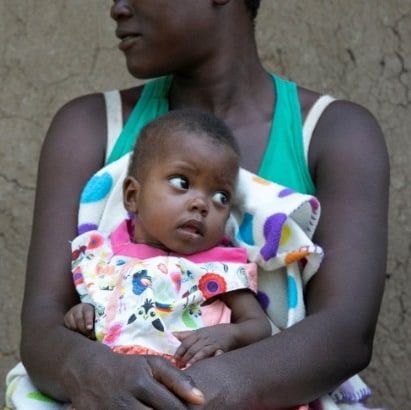Home Visiting Teams Help Young Kenyan Mothers and Babies Stay Healthy
August 25th, 2019 | story
Mothers and families of adolescent girls in Kenya often hold this negative attitude towards their pregnant daughters, which is compounded by concerns and stigma related to HIV. This attitude is a widespread problem, as adolescent girls and young women are disproportionately affected by HIV—over half of new infections in Kenya are among adolescents and young people. These beliefs can negatively impact HIV-positive pregnant and postpartum adolescents, who are a particularly vulnerable group that need increased attention and support so they and their babies are healthy.
Salome Awiti worked for the AIDSFree JUA Program, which provided much-needed support for pregnant adolescents, young mothers, and their children (up to age 2) to improve their HIV and other health and social outcomes. Led by JSI and implemented by the Elizabeth Glaser Pediatric AIDS Foundation in Kenya, the goal of the JUA program was to promote access to and retention in antenatal care (ANC) and postnatal care (PNC) services for pregnant adolescents and young mothers. By enrolling in the JUA program, both HIV-positive and HIV-negative girls received HIV testing, prevention, and treatment services as needed. The program also helped adolescent mothers and their infants receive prevention of mother-to-child transmission (PMTCT) and postpartum services before, during, and after delivery. In addition, the JUA program linked these young women to critical social services to help them stay in or return to school, address gender-based violence, and access livelihood opportunities.
The AIDSFree JUA program piloted a new approach to visit adolescents in the community. The program used a home visiting team model to deploy trained teams to work directly with community members, caregivers, and partners of the adolescents to address the girls’ barriers to care. Home visiting teams included several key members—a peer mentor to the adolescent, a supervisor, a female household facilitator, and a male household facilitator. As a female household facilitator, Salome played an important role in working closely with the mentor to discuss with the adolescent and her mother how they feel about the pregnancy or new motherhood.
A female facilitator is very important because we get more information from the female caregivers,” explained Salome. “We are able to be a go-between the adolescent and her mother.”
The JUA team used both female and male facilitators to reach all of the members of the adolescent’s household. Parents and guardians play an important role in the lives of their adolescent girls, impacting girls’ abilities to receive medical care, attend school, and work outside the home. Some families took convincing to participate in the JUA program. “The families had very high expectations from us,” said Salome. “They are asking us what benefit the families are getting from the program.” JUA team members worked with the parents so they understood the advantages of enrolling their daughter, which allowed her to receive ANC and PNC services as well as HIV services for herself and her infant.

The JUA home visiting teams viewed their role as lifting up the adolescents and their parents together to improve social and health outcomes. With support from their families and team, enrolled adolescents accessed medical care in a timely manner. “We have supported girls to get to the hospital and saved lives of mothers and their infants,” shared Salome.
The JUA home visiting team also established strong relationships between health facilities and their adolescent clients. This connection helped ensure that adolescents gave birth with a skilled attendant, which dramatically increases the likelihood of a safe delivery and healthy baby—a key goal of the JUA program. Irene Akello Makadra, a nurse at the Kotunga Dispensary, discussed this. “The JUA program has made it easy for me to reach out to the girls, especially for their first ANC and skilled delivery,” said Makadra. This was very successful: Nearly all (94%) of the enrolled adolescents who gave birth delivered their babies with the support of a skilled birth attendant—higher than the Kenyan national average of 61%. This helped all infants receive necessary services right away—100% (18/18) of HIV-exposed infants received prophylaxis and HIV testing at age-appropriate visits per the Kenyan guidelines for early infant diagnosis.
Improving birth outcomes also meant helping HIV-positive adolescents access PMTCT services. The JUA program ensured that all 384 pregnant and breastfeeding adolescents received HIV testing services, with 20 identified as HIV- positive and put on antiretroviral therapy during pregnancy and after delivery. For those who were HIV-negative, they receive extensive education on HIV prevention, including safer sex practices.
To achieve an AIDS-free generation, adolescent girls must have the support of their families to use HIV services. “We empower the girls and their families,” said Salome. Family members who participate in the JUA program improved their knowledge and understanding of HIV prevention and treatment, as well as their role in helping adolescents to access ANC and PNC at the health facility. Through the JUA program, families became more supportive of their girls. At the program’s end, over 80% of households were considered supportive of the adolescent and her pregnancy or child—up from just half of households at the start of the program.
Health facilities recognized the important work of the JUA program and its impact on their adolescent clients. “The facility staff have been very supportive,” said Salome. “They are working in partnership with the team, and asking us to take more teenage mothers.” Nurse Makadra echoes this: “I only wish they were able to take more adolescents in the JUA program, because I have many more adolescents who may benefit from the program.” Bringing family members and nurses together to support adolescent girls is no small feat, but the JUA home visiting team knew that only through this coordinated effort could their pregnant and breastfeeding girls achieve optimal birth and HIV outcomes for themselves and their children.
The JUA Program Home Visiting Team model consists of three components:
We strive to build lasting relationships to produce better health outcomes for all.